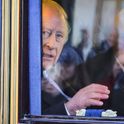“I will see Charles! I will see Charles!” At the Philip Mould Gallery, a woman is desperate to get a look at Jonathan Yeo’s new portrait of the King. She’s rearranged her whole day to see it. “I’m from the US, of course.”
Philip Mould, gallery owner and Fake or Fortune presenter, is showing the painting to a group of students from Stowe boarding school. It is, he tells them, “The most exciting day in our lives as art dealers for many a year.” Right now, he claims, the seven-and-a-half foot tall image—which will hang at his gallery for a month, before replacing the Queen’s portrait at the Drapers’ Hall in the City—is the most famous painting in the world.
But Yeo’s portrait is not necessarily famous for good reasons. The obvious point: the whole painting, except Charles’s face and fleshy hands, is drenched in red. On social media, people have said it looks like he’s bathing in blood—a nod, some claimed, to the brutal legacy of the monarchy (or to the King’s desire to be Camilla’s tampon, as per that infamous leaked phone call from 1989). The Guardian gave it one star, calling it a “right royal banality”. One of the Stowe teenagers says it looks like something from a horror movie.
And yet—I think I like it. He looks like a lined old man. Slightly more handsome than the real thing, sure, but not absurdly so. He wears the uniform of the colonel of the Welsh Guards. But washed out by the red, the military garb is barely noticeable. His sword looks more like a walking stick. And if the face is somewhat generously portrayed, the fingers aren’t. Stark against the sea of red, Charles’s famous sausage-like fingers seem to loom even larger than usual.
“I do my best to capture the life experiences etched into any individual sitter’s face,” Yeo has said elsewhere of his process. When he started this portrait a few years ago, Charles was still the Prince of Wales. By the time it was completed—which took four sittings over two years—his mother had died and he’d become king. His relationship with his younger son had publicly worsened. In his memoir, Spare, Prince Harry recounts his father imploring one day: “Please boys—don’t make my final years a misery.” What this adds up to, in paint, is a picture of a man who isn’t particularly happy.
A lot of people have objected to the red wash, but the worst thing about the painting is the butterfly (a monarch—get it?) hovering above his right shoulder. This, apparently, was Charles’s idea. Mould says Charles told him that monarch butterflies are “beautiful”, and that one did indeed once land on his shoulder. The butterfly is meant to symbolise both his commitment to conservation and the environment, and his metamorphosis from Prince to King. Plus, monarchs are a species teetering on extinction. Its inclusion could be a nod to Charles’s own frailty, or to the precarity of the royal family, at a time when half of Britons say abolishing the monarchy would make the country better, or at least make no difference. But it feels a bit didactic—like it’s been shoved in last minute to make a trite point.
At yesterday’s grand unveiling, Charles could be heard muttering “Christ” as he pulled down the heavy cloth to reveal the portrait. Amid the chattering that followed, Camilla, at least, seemed to approve of the likeness; “You’ve got him,” she told Yeo. Charles, by contrast, seemed startled to see this giant version of himself. Standing beside it, he looked fragile.















